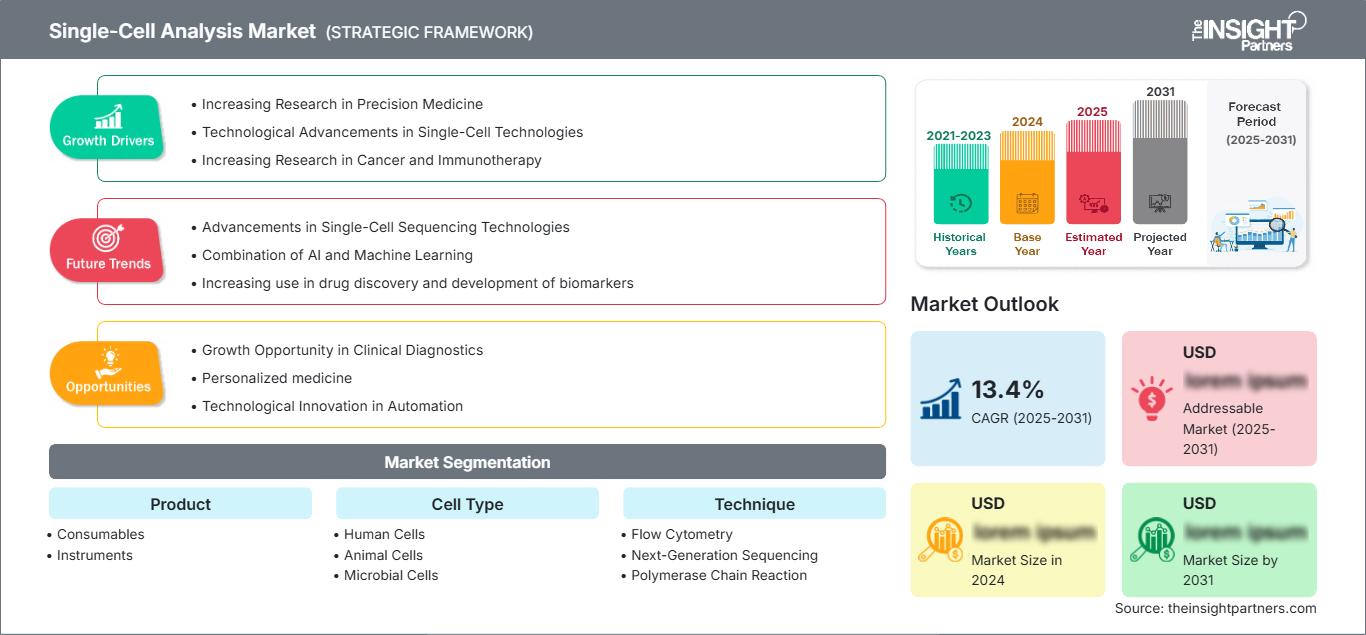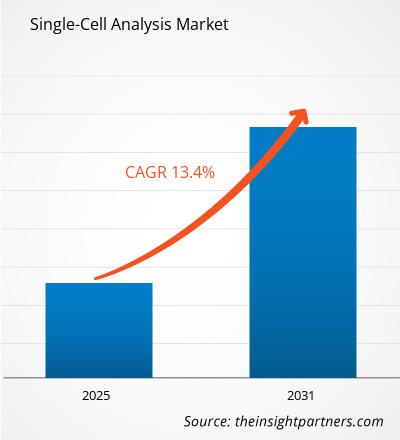The Single Cell Analysis Market size is expected to reach US$ 14.35 billion by 2031. The market is anticipated to register a CAGR of 15.7% during 2025-2031.
The Single-Cell Analysis Market is categorized by product into the following subsegments: Consumables, Instruments. It further presents an analysis based on cell type, i.e., Human Cells, Animal Cells, Microbial Cells; technique, i.e., Flow Cytometry, Next-Generation Sequencing, Polymerase Chain Reaction, Microscopy, Mass Spectrometry, Other Techniques; and application, i.e., Research Applications, Medical Applications; and end-user, i.e., Academic and Research Laboratories, Biotechnology and Pharmaceutical Companies, Hospitals and Diagnostic Laboratories, Cell Banks and IVF Centers. The global analysis is broken down at the regional level and major countries. The market evaluation is presented in US$ for the above segmental analysis.
Purpose of the Report
The report Single-Cell Analysis Market by The Insight Partners aims to describe the present landscape and future growth, top driving factors, challenges, and opportunities. This will provide insights to various business stakeholders, such as:
- Technology Providers/Manufacturers: To understand the evolving market dynamics and know the potential growth opportunities, enabling them to make informed strategic decisions.
- Investors: To conduct a comprehensive trend analysis regarding the market growth rate, market financial projections, and opportunities that exist across the value chain.
- Regulatory bodies: To regulate policies and police activities in the market with the aim of minimizing abuse, preserving investor trust and confidence, and upholding the integrity and stability of the market.
Single-Cell Analysis Market Segmentation Product
- Consumables
- Instruments
Cell Type
- Human Cells
- Animal Cells
- Microbial Cells
Technique
- Flow Cytometry
- Next-Generation Sequencing
- Polymerase Chain Reaction
- Microscopy
- Mass Spectrometry
- Other Techniques
Application
- Research Applications
- Medical Applications
End User
- Academic and Research Laboratories
- Biotechnology and Pharmaceutical Companies
- Hospitals and Diagnostic Laboratories
- Cell Banks and IVF Centers
You will get customization on any report - free of charge - including parts of this report, or country-level analysis, Excel Data pack, as well as avail great offers and discounts for start-ups & universities
Single-Cell Analysis Market: Strategic Insights

-
Get Top Key Market Trends of this report.This FREE sample will include data analysis, ranging from market trends to estimates and forecasts.
Single-Cell Analysis Market Growth Drivers
- Increasing Research in Precision Medicine: With the focus on personalized medicine, the need for single-cell analysis is also rising to understand the mechanisms of the diseases and targeted therapies.
- Technological Advancements in Single-Cell Technologies: Advancements in single-cell sequencing, CRISPR gene editing, and microfluidics are contributing to the growth of single-cell analysis, because all these enhancements allow more accurate and efficient analyses.
- Increasing Research in Cancer and Immunotherapy: Single-cell analysis is increasingly being used in cancer research, particularly to study tumor heterogeneity as well as response to immunotherapies, which is driving the market growth.
Single-Cell Analysis Market Future Trends
- Advancements in Single-Cell Sequencing Technologies: The emergence of single-cell RNA sequencing (scRNA-seq) is revolutionizing gene-expression analysis, thereby letting researchers uncover cellular diversity and developmental processes.
- Combination of AI and Machine Learning: AI is used for the huge number of data generated in single-cell technologies for better insight and faster results.
- Increasing use in drug discovery and development of biomarkers: Single-cell analysis is being applied in research for new markers for disease diagnosis and therapy development, especially in oncology and immunology.
Single-Cell Analysis Market Opportunities
- Growth Opportunity in Clinical Diagnostics: Expansion in Clinical Diagnostics In clinical diagnostics, expansion is presented through the ability of single-cell analysis to enhance diagnostic competency, especially in oncology.
- Personalized medicine: Individual therapy according to the behavior of their cells opens new avenues for precision medicine and more precise and targeted therapies.
- Technological Innovation in Automation: Huge opportunities exist in large-scale research and clinical labs in developing automated single-cell analysis systems that would reduce the costs and increase throughput.
The regional trends and factors influencing the Single-Cell Analysis Market throughout the forecast period have been thoroughly explained by the analysts at The Insight Partners. This section also discusses Single-Cell Analysis Market segments and geography across North America, Europe, Asia Pacific, Middle East and Africa, and South and Central America.
Single-Cell Analysis Market Report Scope
| Report Attribute | Details |
|---|---|
| Market size in 2024 | US$ XX Billion |
| Market Size by 2031 | US$ 14.35 billion |
| Global CAGR (2025 - 2031) | 15.7% |
| Historical Data | 2021-2023 |
| Forecast period | 2025-2031 |
| Segments Covered |
By Product
|
| Regions and Countries Covered |
North America
|
| Market leaders and key company profiles |
|
Single-Cell Analysis Market Players Density: Understanding Its Impact on Business Dynamics
The Single-Cell Analysis Market is growing rapidly, driven by increasing end-user demand due to factors such as evolving consumer preferences, technological advancements, and greater awareness of the product's benefits. As demand rises, businesses are expanding their offerings, innovating to meet consumer needs, and capitalizing on emerging trends, which further fuels market growth.

- Get the Single-Cell Analysis Market top key players overview
Key Selling Points
- Comprehensive Coverage: The report comprehensively covers the analysis of products, services, types, and end users of the Single-Cell Analysis Market, providing a holistic landscape.
- Expert Analysis: The report is compiled based on the in-depth understanding of industry experts and analysts.
- Up-to-date Information: The report assures business relevance due to its coverage of recent information and data trends.
- Customization Options: This report can be customized to cater to specific client requirements and suit the business strategies aptly.
The research report on the Single-Cell Analysis Market can, therefore, help spearhead the trail of decoding and understanding the industry scenario and growth prospects. Although there can be a few valid concerns, the overall benefits of this report tend to outweigh the disadvantages.
Frequently Asked Questions
What are the deliverable formats of the Single-Cell Analysis Market?
What are the options available for the customization of this report?
Which are leading players in Single-Cell Analysis Market?
What is the expected CAGR in Single-Cell Analysis Market?
What are the future trends of Single-Cell Analysis Market?
What are driving factors impacting the Single-Cell Analysis Market?
- Historical Analysis (2 Years), Base Year, Forecast (7 Years) with CAGR
- PEST and SWOT Analysis
- Market Size Value / Volume - Global, Regional, Country
- Industry and Competitive Landscape
- Excel Dataset
Recent Reports
Related Reports
Testimonials
Reason to Buy
- Informed Decision-Making
- Understanding Market Dynamics
- Competitive Analysis
- Identifying Emerging Markets
- Customer Insights
- Market Forecasts
- Risk Mitigation
- Boosting Operational Efficiency
- Strategic Planning
- Investment Justification
- Tracking Industry Innovations
- Aligning with Regulatory Trends





















 Get Free Sample For
Get Free Sample For